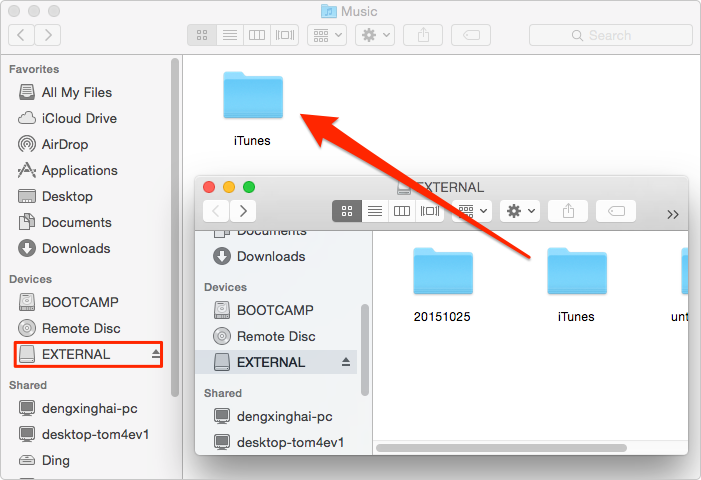-
Transfer Itunes Library To New Computer Mac
- The easier thing to do would be to copy your music on to an external hard drive then you could plug that in to the new MB and change the path in iTunes to pull your library from the HD. Downside, you have to have the HD plugged in to the computer to play music.
- Mar 06, 2019 iMusic - Most Excellent Music Tool to Transfer iTunes Library from Mac to PC Transfer iTunes Library from Mac to PC without erasing or lose the files. Record music in original quality and automatically split the ads. Discover and download music from more than 300,000 songs. Transfer music between any two devices directly without iTunes.
Contents
There are a few ways to transfer your iTunes library from one computer to another: When you get a new Mac, use Setup Assistant (or Migration Assistant, if you’re switching from Windows) to move files — including your iTunes files — from your old computer to the new one. See the Apple Support article Back up and restore your iTunes Library.
- iTunes from Mac to Mac
Part 1: How to Transfer iTunes Library from Mac to Mac
Often, Mac users will have more than one Mac in their home. It is the nature of the beast, as they may be so pleased with their exclusive Mac environment that there may suddenly be a MacBook or an iMac in the house where there may have been only one Mac computer previously. So, like households with both PC and Mac systems in them, households with more than one Mac may decide that it’s time to copy their iTunes library from one Mac to another. There are a number of steps to follow when transferring iTunes from one Mac computer to the other, just as there are when you transfer iTunes from PC to Mac. Here is how it’s done:

Step 1. Open iTunes. Go to Preferences > Advanced
From there, click “Keep iTunes Media folder organized” in order to see your iTunes folder stay properly organized and keep the transition from one computer to the other smooth.
Step 2. Deauthorize your computer from the iTunes store
It’s important to ensure that you deauthorize your old computer from the iTunes Store if you are planning on not using your old computer on iTunes anymore. All you need to do is go to Store>Deauthorize this computer, and your old computer will be deauthorized.
Step 3. Move your iTunes Media Folder
From here, it’s simply a matter of closing iTunes on your old computer and moving your iTunes Media folder across the network to your new computer. Locate the Music folder (~/Music) and use either an external hard drive or a wired or wireless network to get the job done.
Step 4. Change the Library on the new computer
Move the iTunes folder to the same location on the new machine as you had it on the old machine. This will help your iTunes on your new computer locate all the music files on your new machine.
Step 5. Launch iTunes while holding down the Option key
A dialog box will open, asking whether you want to 'Cancel', 'Create a new library', or 'Choose an Existing Library'. Select 'Choose Library', then navigate to where you moved the iTunes folder. Remember that you will overwrite any existing music files in your library.
Step 6. Authorize the new computer in the iTunes Store
This allows you to get any authorized purchases in your iTunes account.
How delete photos from mac photos library. While Mac may be the platform of choice for many iTunes users, there are multiple users who have iTunes for PC and may be looking at transferring iTunes to another PC system. Therefore, it is important to know how to transfer iTunes from one PC to another.
Transfer iPhone/iPad/iPod touch music, videos and photos to Mac and iTunes.
One-click backup to iTunes and manage your songs, videos, and photo albums.
- Copy music from iPhone, iPod, iPad to Mac or iTunes.
- Export videos from iPhone, iPad, iPod to iTunes/Mac.
- Transfer all photos from photo album to Mac or iTunes.
- Copy playlists with rating and play counts to iTunes.
:max_bytes(150000):strip_icc()/itunes12-9-macbook-air-itunes-match-hero-5c6db49dc9e77c00016930a4.jpg) 17 10 likes 36,482 views Last modified Nov 30, 2019 5:15 PM
17 10 likes 36,482 views Last modified Nov 30, 2019 5:15 PMIn most cases you simply need to copy the entire iTunes folder from your old computer into the user's music folder of the new computer, then deauthorize the old computer if you no longer wish to access protected iTunes content on it.
This approach works well as long as your library is in the usual layout where all of the media connected to the iTunes library is inside the iTunes Media folder, which in turn is inside the iTunes folder holding the library database file. If your library is not in this standard shape, perhaps because you've placed the media folder on a different drive, or have added media from various different locations without making copies in the media folder, then you either need to copy each of the components of the library to matching paths on the new computer or see Make a split library portable for advice on manipulating the library into a portable layout that can be copied to a new location without breaking the links to the media.
You can copy your library over a network share, or copy it to an external drive, move the drive between computers, then copy it into the new computer. However a better approach is to maintain a regular backup of the iTunes library, update the backup when you want to switch computers, restore the library to the new machine, then regularly maintain the backup going forward. See Backup your iTunes for Windows library with SyncToy for a suggested backup strategy. Backing up the library in this fashion ensures you have a working clone of the library on an external drive that you can connect to at any time if needed.
A portable library can be copied or restored to a location other than the standard user's music folder, which is probably the best approach if your computer has a small SSD system drive. If you want to place your library on a different path, typically the root of a drive, then press and hold down shift (Win) or option (Mac) as you start iTunes to get the option to create or choose a new library, select choose, then browse to the folder that contains your library and select the iTunes Library.itl file inside. See Open a different iTunes Library file or create a new one - Apple Support for details.
If you think that you've moved your library correctly but cannot see your expected content when you open the library, or you see cloud links to items which should be stored locally, then see Empty/corrupt iTunes library after upgrade/crash. If you have difficulty updating content see Repair security permissions for iTunes for Windows or Repair security permissions for iTunes for Mac as appropriate.
As long as you move the library properly any devices that you have will sync with it as if nothing has changed. Note however that if you have iOS devices and haven't moved your contacts and calendar items across to your new computer then you should create one dummy entry of each in your new profile and iTunes should merge the existing data from the device. Otherwise the data on your device may be replaced with the empty lists from the computer.
You don't generally need to copy over your iOS device backups if your devices are working normally as fresh backups will be made during the first sync on the new computer. If you still wish to keep your old backup sets for any reason, e.g. moving backup data from a Vista or XP system to restore to an iOS 10 or later device in a newer version of iTunes, then see Locate backups of your iPhone, iPad, and iPod touch - Apple Support for information on the folder you need to copy across. See Relocate iOS device backups if you want to move the backup data from the system drive for reasons of space.
Mac OS X: Finding & Fixing Corrupt Preference Files. That some preference files live within the /Library/Preferences folder at the top level of your hard drive, but you’ll need to be a bit. /Users//Library/ Preference s (or /Library/Preferences) This is where preferences are stored for each individual user account, that apply to that individual account only /Library/Preferences. Perhaps you wanted to tweak something using a tip from Macworld, Mac OS X. User has munged the contents of /Library—a user can have plenty of valid reasons for needing to access the personal. User library preferences mac. Jan 12, 2020 Launch Terminal, located in /Applications/Utilities. Enter the following command at the Terminal prompt: Press Return. Once the command executes, you can quit Terminal. The Library folder will now be visible in the Finder. Should you ever wish to set the Library folder back to its default hidden.
Should you be in the unfortunate position where you have replaced your computer and are no longer able to access your original library or a backup of it then then see Recover your iTunes library from your iPod or iOS device for advice on how to set up your devices with a new library with the maximum preservation of data.
See also How to move your iTunes library to a new computer - Apple Support for Apple's approach to this topic.
Transfer Cd To Itunes Library
macOS 10.15 Catalina
Transfer Itunes Playlist To New Computer
The same basic approach as above will work for moving a library from one Catalina system to another. If moving an iTunes library from an older version of OS X/macOS to Catalina then it will be best to start with the library in the portable shape. In Catalina you can then option-start-Music to access the iTunes Library.itl file and migrate it into Music. You can repeat with TV.

